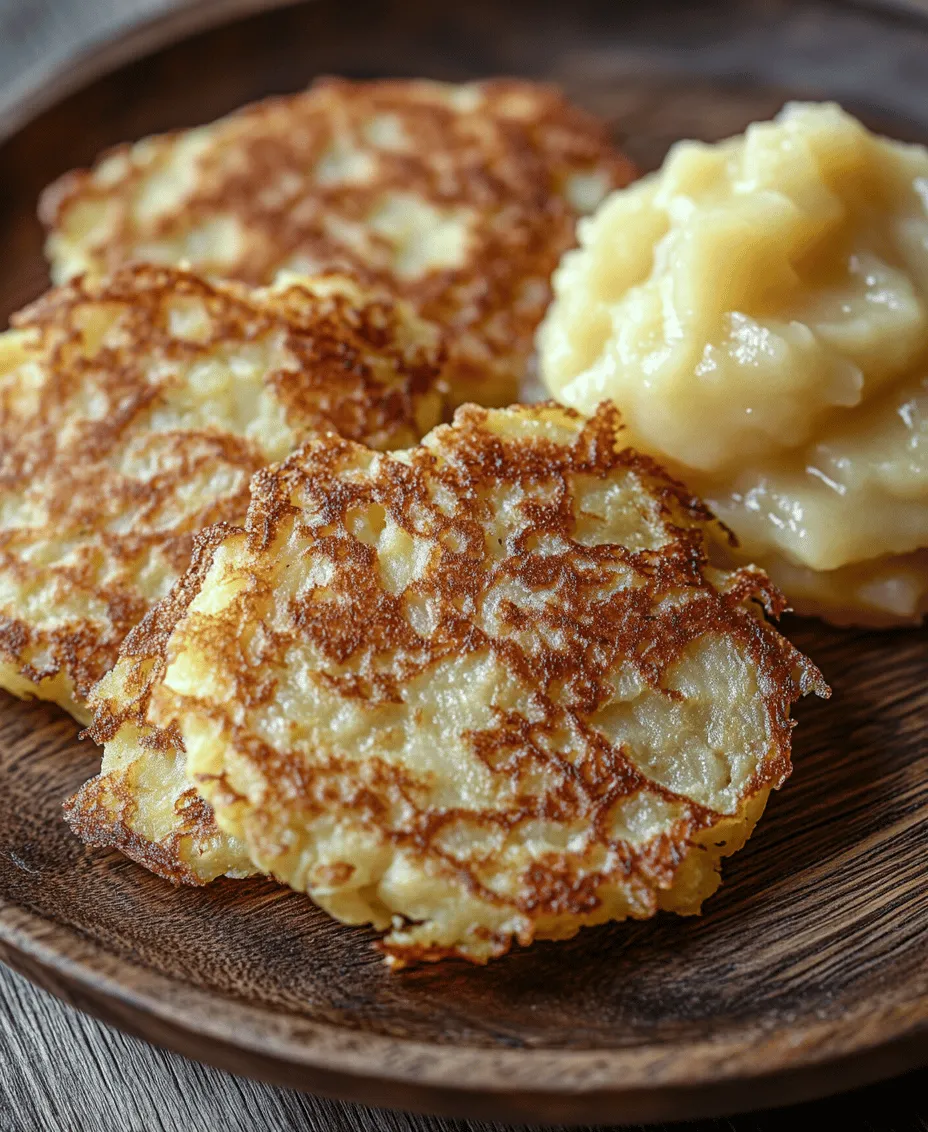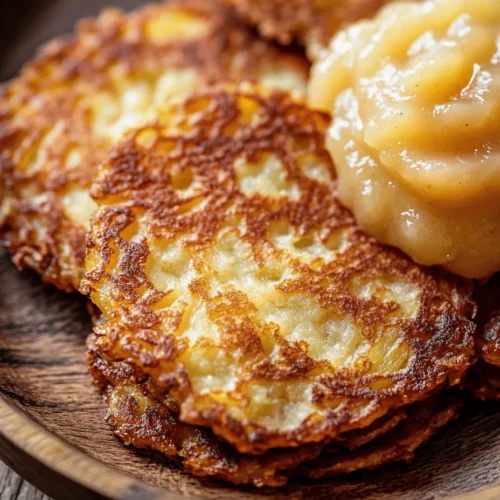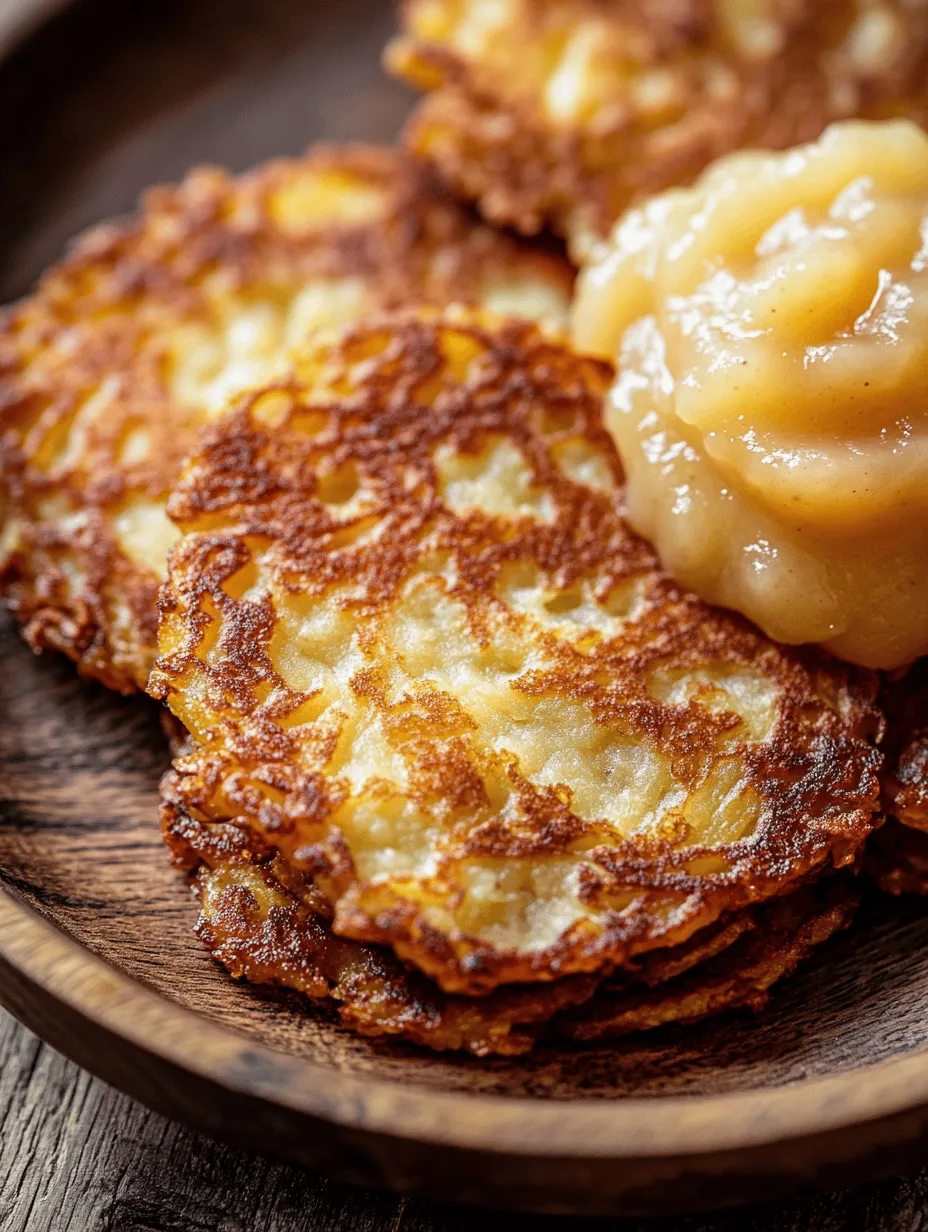Crispy Kartoffelpuffer, also known as German potato pancakes, are a cherished traditional dish that delights with their golden-brown crust and soft, flavorful interior. These delectable pancakes, often enjoyed during festive seasons or family gatherings, are more than just a meal; they represent a slice of German culture and culinary history. As comfort food goes, Kartoffelpuffer holds a special place in the hearts and homes of food enthusiasts worldwide, transcending geographical boundaries to become a beloved dish in various cuisines.
Originating from Eastern European roots, Kartoffelpuffer have evolved over centuries, becoming a staple across Germany and beyond. Traditionally, they were a way to utilize leftover potatoes, showcasing the resourcefulness of home cooks. Today, they delight diners with their simple yet satisfying flavor, commonly served with accompaniments like applesauce or sour cream, which enhance their taste and provide a delightful contrast to the crispy texture. Whether enjoyed as a main course, side dish, or snack, Kartoffelpuffer are versatile and easy to prepare, making them perfect for cozy weeknight dinners or festive occasions.
In this article, we will delve into the origins of Kartoffelpuffer, their cultural significance, and provide a comprehensive guide to making them from scratch. With just a few ingredients and straightforward steps, you can bring this authentic German dish to your kitchen and impress your family and friends with your culinary skills. Let’s start by understanding the key ingredients that contribute to the perfect Kartoffelpuffer.
Understanding the Ingredients for Kartoffelpuffer
When preparing Kartoffelpuffer, the quality and type of ingredients are crucial for achieving the perfect texture and flavor. Here’s a closer look at the core components of this recipe:
Highlighting the Importance of Starchy Potatoes
Starchy potatoes are the foundation of any great Kartoffelpuffer. Varieties like Russet or Yukon Gold are ideal due to their high starch content, which helps create a crispy exterior while maintaining a fluffy interior. When selecting potatoes, aim for those that feel firm and have smooth skin, avoiding any that are sprouted or have green spots. The starch in these potatoes is essential for binding the mixture and ensuring the pancakes hold their shape during cooking.
The Role of Onions in Flavor Enhancement
Onions play a pivotal role in enhancing the overall flavor profile of Kartoffelpuffer. They add a subtle sweetness and depth, balancing the starchy potatoes. For the best results, choose medium-sized yellow onions, as they provide the perfect flavor without overpowering the dish. When finely grated or chopped, onions blend seamlessly into the potato mixture, ensuring every bite bursts with flavor.
Eggs and Flour: Binding Agents for Perfect Texture
Eggs and flour are essential ingredients in Kartoffelpuffer, serving as binding agents that hold the pancake mixture together. Eggs provide moisture and richness, while flour adds structure, resulting in a cohesive texture. When selecting flour, use all-purpose flour for optimal results, as it strikes the right balance between binding and lightness. The combination of these ingredients contributes to the delightful texture that distinguishes crispy Kartoffelpuffer from other potato dishes.
Seasoning Essentials: Salt, Pepper, and Nutmeg
To elevate the flavor of your Kartoffelpuffer, don’t overlook the importance of seasoning. A simple mixture of salt and pepper enhances the natural flavors of the potatoes and onions. Nutmeg, a traditional addition in many German potato recipes, adds a warm, aromatic note that complements the dish beautifully. Be sure to season the mixture adequately, as proper seasoning is key to bringing out the best in your Kartoffelpuffer.
Choosing the Right Oil for Frying: Vegetable Oil Explained
Frying is the final step in creating the perfect Kartoffelpuffer, and the choice of oil is crucial for achieving the desired crispiness. Vegetable oil is a popular choice due to its high smoke point and neutral flavor, allowing the pancakes to fry evenly without imparting unwanted tastes. Other options like canola or sunflower oil also work well. Regardless of the oil you choose, ensure it is heated adequately before adding the potato mixture to avoid soggy pancakes.
Step-by-Step Guide to Making Kartoffelpuffer
Now that we’ve covered the essential ingredients, let’s dive into the steps for making Kartoffelpuffer from scratch. This comprehensive guide will walk you through each stage, ensuring you achieve crispy, delicious results every time.
Preparing the Potatoes: Techniques for Optimal Texture
The first step in making Kartoffelpuffer is preparing your potatoes. Begin by peeling the potatoes to remove the skin, which can be tough and detracts from the final texture. Once peeled, wash the potatoes thoroughly to remove any dirt or impurities.
To retain the starch and moisture, it’s best to work with the potatoes quickly after peeling. If you need to postpone grating, place the peeled potatoes in a bowl of cold water to prevent browning. However, for the crispiest results, grating should be done just before frying to maintain the optimal moisture content.
Grating and Moisture Removal: Key to Crispy Pancakes
Grating the potatoes is a pivotal step in achieving the desired texture for your Kartoffelpuffer. Using a box grater or a food processor, grate the potatoes into fine shreds. The finer the shreds, the easier it will be for them to bind together during cooking.
After grating, it’s essential to remove excess moisture from the potato shreds. Place the grated potatoes in a clean kitchen towel or cheesecloth and twist it tightly to squeeze out as much liquid as possible. Too much moisture can lead to soggy pancakes, so this step is crucial for ensuring a crispy finish. Once the moisture is removed, transfer the grated potatoes to a mixing bowl and combine them with the finely grated onions.
Mixing Ingredients: Ensuring Even Distribution of Flavors
With your potatoes and onions ready, it’s time to mix the rest of the ingredients. In your mixing bowl, add the eggs, flour, salt, pepper, and nutmeg. Use a fork or a spatula to gently combine the ingredients, ensuring that the potatoes and onions are evenly coated with the egg and flour mixture. Be careful not to overmix, as this can lead to dense pancakes. The goal is to have a cohesive mixture that holds together but retains the texture of the grated potatoes.
Heating the Oil: Identifying the Right Temperature for Frying
Before you begin frying, it’s crucial to heat the oil to the right temperature. In a large skillet or frying pan, pour enough vegetable oil to cover the bottom with about a quarter-inch depth. Heat the oil over medium-high heat until it shimmers but does not smoke. A good way to test if the oil is ready is to drop a small spoonful of the potato mixture into the skillet; if it sizzles immediately, the oil is hot enough for frying.
Once the oil is hot, proceed to the next step of forming and frying your Kartoffelpuffer, ensuring they are perfectly crispy on the outside and tender on the inside.
Stay tuned for the next part, where we will explore the frying process in detail, along with tips for serving and storing your delicious crispy potato pancakes.

Forming the Panccakes: Tips for Consistency and Shape
Once you have your potato mixture ready, the next step is to form the pancakes. Achieving the right consistency and shape is crucial for ensuring that your Kartoffelpuffer turn out perfectly crispy. Start by taking a generous scoop of the potato mixture—about 1/4 cup—and using your hands, gently squeeze out any excess moisture. This is a key step; too much moisture will lead to soggy pancakes.
To shape the pancakes, flatten the scooped mixture into a disk about 1/2 inch thick. Make sure that the edges are slightly thinner than the center to encourage even cooking. A uniform thickness will help the Kartoffelpuffer cook evenly, resulting in a delightful crispy exterior and a tender interior. It’s also advisable to form all of your pancakes before you start frying. This way, you can maintain a consistent cooking temperature in the pan.
Frying to Perfection: Achieving the Ideal Golden Brown
Frying is where the magic happens, transforming your potato mixture into crispy golden-brown Kartoffelpuffer. Heat a generous amount of oil (about 1/4 inch deep) in a large skillet over medium-high heat. You want the oil to be hot but not smoking; a quick test is to drop a small amount of the potato mixture into the oil. If it sizzles immediately, the oil is ready.
Carefully place the formed pancakes into the hot oil, making sure not to overcrowd the pan. This is crucial; too many pancakes at once can lower the oil temperature and lead to greasy results. Fry each side for about 3 to 4 minutes, or until they are beautifully golden brown. When you flip the pancakes, use a spatula to gently press down on them, ensuring they make good contact with the hot oil for that perfect crispy texture.
Once the Kartoffelpuffer are cooked on both sides, they should be removed from the skillet and drained on a paper towel-lined plate. This will help remove any excess oil, keeping your pancakes light and crispy.
Draining Excess Oil: Importance of Proper Oil Removal
Draining excess oil is a critical step in achieving the perfect Kartoffelpuffer. Without proper draining, your pancakes may end up greasy and unappetizing. After frying, place each pancake on a wire rack or a plate lined with paper towels. This will allow any remaining oil to drip off and help maintain their crispy texture.
If you find that your pancakes are still oily after draining, consider placing them in a preheated oven at 200°F (93°C) while you finish frying the rest. This will keep them warm without making them soggy, and it also allows any residual oil to continue dripping off.
Serving Suggestions: Traditional Accompaniments to Kartoffelpuffer
Kartoffelpuffer are versatile and can be served with a variety of accompaniments that enhance their flavor. Traditionally, they are served with applesauce, which provides a sweet contrast to the savory pancakes. The tartness of the applesauce complements the crispy texture, making it a classic pairing.
Sour cream is another popular option, offering a rich and creamy contrast that balances the crispiness of the Kartoffelpuffer. For those who enjoy a bit of tang, a dollop of crème fraîche or even a sprinkle of chives can elevate the dish further.
In Germany, Kartoffelpuffer are also enjoyed as a street food snack, often served with a side of fresh salad or sauerkraut. This not only provides a refreshing contrast but also adds a touch of acidity to cut through the richness of the pancakes.
Cultural Significance of Kartoffelpuffer in German Cuisine
Historical Context: The Origins of Kartoffelpuffer
Kartoffelpuffer, or potato pancakes, hold a special place in German culinary tradition. Their origins can be traced back to the 18th century, when potatoes were introduced to Europe from the Americas. Initially met with skepticism, they eventually became a staple food due to their versatility and nutritional value. Kartoffelpuffer emerged as a way to utilize leftover potatoes, and over time, they became a beloved dish across Germany.
Regional Variations: How Different Areas in Germany Serve Them
The preparation and serving of Kartoffelpuffer can vary significantly from region to region within Germany. In the northern states, for example, they may be served with a fish accompaniment, while in the southern regions, they might be enjoyed alongside hearty meat dishes. Some areas incorporate additional ingredients like onions or herbs into the mixture, resulting in unique flavor profiles. These regional variations reflect the diverse culinary landscape of Germany and highlight how Kartoffelpuffer can adapt to local tastes and traditions.
Kartoffelpuffer in Celebration: Their Role in Festivals and Holidays
Kartoffelpuffer are not only a common everyday dish but also play a significant role in German festivals and holidays. During Christmas markets, for example, they are a popular treat, often served hot and fresh to eager patrons. The smell of sizzling potato pancakes fills the air, drawing crowds who gather to enjoy this comforting, nostalgic dish. Additionally, they are often featured at Jewish celebrations, particularly during Hanukkah, where they are known as latkes, further showcasing their cultural significance.
Modern Adaptations: How Chefs Are Reinventing This Classic Dish
In recent years, chefs around the world have begun to reinvent Kartoffelpuffer, introducing new flavors and techniques to modernize this classic dish. From incorporating sweet potatoes and zucchini into the batter to experimenting with global spices, these adaptations showcase the versatility of Kartoffelpuffer. Some chefs even serve them as gourmet appetizers, topped with unique ingredients like smoked salmon or avocado, elevating the traditional pancake to new culinary heights.
Nutritional Benefits of Kartoffelpuffer
Understanding the Nutritional Profile of Key Ingredients
While Kartoffelpuffer are certainly a treat, they can also be a nutritious choice when prepared with care. The primary ingredient, potatoes, are an excellent source of carbohydrates, providing energy and essential vitamins, particularly vitamin C and B6. They also contain potassium, which is important for heart health.
When you include onions in the mixture, you add antioxidants and anti-inflammatory properties, enhancing the overall nutritional profile. Additionally, using healthier oils like olive oil or avocado oil for frying can further boost the health benefits of this dish.
Balancing Flavor and Health: Making Kartoffelpuffer Healthier
For those looking to enjoy Kartoffelpuffer while keeping health in mind, there are a few simple adjustments you can make. Consider baking the pancakes instead of frying them. While they may not achieve the same level of crispiness, they can still be delicious and significantly lower in calories.
Another option is to substitute part of the potatoes with vegetables like zucchini or carrots, increasing fiber and nutrient content while maintaining flavor. Using whole grain flour instead of white flour can also add more fiber and nutrients, making each bite a bit healthier.
Serving Size and Portion Control for Enjoyment Without Guilt
When it comes to enjoying Kartoffelpuffer, portion control is key. A serving of two to three pancakes can be satisfying without overindulging. Pairing them with a fresh salad or vegetable side can help create a well-rounded meal without compromising on flavor. By being mindful of portion sizes, you can savor the deliciousness of Kartoffelpuffer while still adhering to a balanced diet.
Conclusion: Embrace the Joy of Cooking Kartoffelpuffer
Crispy Kartoffelpuffer are more than just a meal; they are a connection to tradition, culture, and family. With the right ingredients and techniques, you can recreate this authentic German dish in your own kitchen, bringing a taste of Germany to your table. Whether enjoyed on their own or paired with your favorite condiments, these potato pancakes are sure to delight everyone who tries them.
Embrace the joy of cooking Kartoffelpuffer, and share this delicious recipe with your loved ones, creating memories that will last a lifetime. The process of making these pancakes is not just about preparing food; it’s about honoring a rich culinary heritage and enjoying the fruits of your labor around a table filled with laughter and love. So gather your ingredients, roll up your sleeves, and dive into the delightful world of Kartoffelpuffer—your taste buds will thank you!



